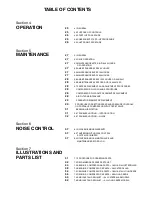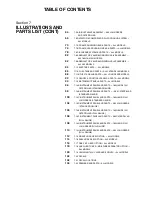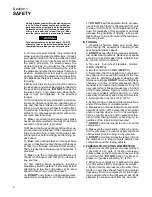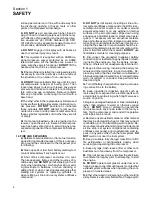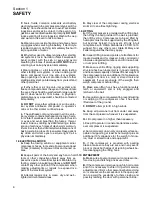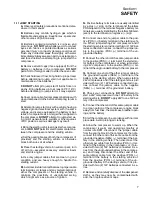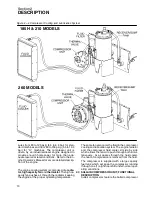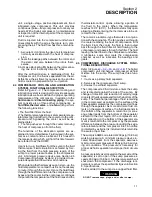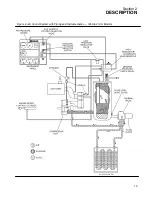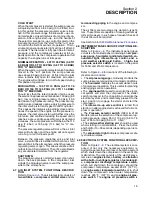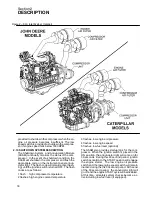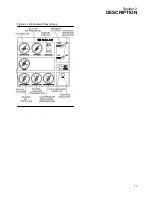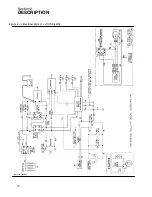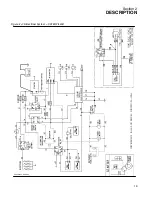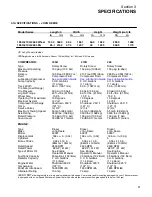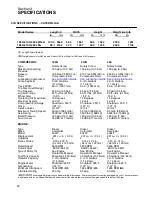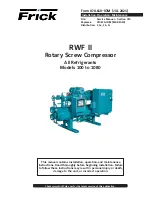
Section 1
SAFETY
7
1.11 JUMP STARTING
A.
Observe all safety precautions mentioned else-
where in this manual.
B.
Batteries may contain hydrogen gas which is
flammable and explosive. Keep flames, sparks and
other sources of ignition away.
C.
Batteries contain acid which is corrosive and
poisonous.
DO NOT
allow battery acid to contact
eyes, skin, fabrics or painted surfaces as serious
personal injury or property damage could result.
Flush any contacted areas thoroughly with water
immediately. Always wear an acid---resistant apron
and face shield when attempting to jump start the
compressor.
D.
Remove all vent caps (if so equipped) from the
battery or batteries in the compressor.
DO NOT
permit dirt or foreign matter to enter the open cells.
E.
Check fluid level. If low, bring fluid to proper level
before attempting to jump start (not applicable to
maintenance---free batteries).
F. DO NOT
attempt to jump start if fluid is frozen or
slushy. Bring batteries up to at least 60
_
F (16
_
C)
before attempting to jump start or it may explode.
G.
Cover open cells of all compressor batteries with
clean dampened cloths before attempting to jump
start.
H.
Attempt to jump start only with a vehicle having a
negative ground electrical system with the same
voltage, and is also equipped with a battery or bat-
teries of comparable size or larger than supplied in
the compressor.
DO NOT
attempt to jump start us-
ing motor generator sets, welders or other sources
of DC power as serious damage may result.
I.
Bring the starting vehicle alongside the compres-
sor, but
DO NOT
permit metal to metal contact be-
tween the compressor and the starting vehicle.
J.
Set the parking brakes of both the compressor ( if
provided) and the starting vehicle or otherwise
block both sides of all wheels.
K.
Place the starting vehicle in neutral or park, turn
off all non---essential accessory electrical loads
and start its engine.
L.
Use only jumper cables that are clean, in good
condition and are heavy enough to handle the
starting current.
M.
Avoid accidental contact between jumper cable
terminal clips or clamps and any metallic portion of
either the compressor or the starting vehicle to
minimize the possibility of uncontrolled arcing
which might serve as a source of ignition.
N.
Positive battery terminals are usually identified
by a plus (+) sign on the terminal and the letters
POS adjacent to the terminal. Negative battery ter-
minals are usually identified by the letters NEG ad-
jacent to the terminal or a negative (---) sign.
O.
Connect one end of a jumper cable to the posi-
tive (POS) (+) battery terminal in the starting vehi-
cle. When jump starting 24V compressors and if
the starting vehicle is provided with two (2) 12V bat-
teries connected in series, connect the jumper ca-
ble to the positive (POS) (+) terminal of the un-
grounded battery.
P.
Connect the other end of the same jumper cable
to the positive (POS) (+) terminal of the starter mo-
tor battery in the compressor, or when jump start-
ing 24V compressor, to the positive (POS) (+) ter-
minal of the ungrounded battery in the compressor.
Q.
Connect one end of the other jumper cable to
the grounded negative (NEG) (---) terminal of the
battery in the starting vehicle. When jump starting
24V compressors and if the starting vehicle is pro-
vided with two (2) 12V batteries connected in se-
ries, connect the jumper cable to the negative
(NEG) (---) terminal of the grounded battery.
R.
Check your connections.
DO NOT
attempt to
start a 24V compressor with one 12V battery in the
starting vehicle.
DO NOT
apply 24V to one 12V bat-
tery in the compressor.
S.
Connect the other end of this same jumper cable
to a clean portion of the compressor engine block
away from fuel lines, the crank case breather open-
ing and the battery.
T.
Start the compressor in accordance with normal
procedure. Avoid prolonged cranking.
U.
Allow the compressor to warm up. When the
compressor is warm and operating smoothly at
normal idle RPM, disconnect the jumper cable
from the engine block in the compressor, then dis-
connect the other end of this same cable from the
grounded negative (NEG) (---) terminal of the bat-
tery in the starting vehicle. Then disconnect the
other jumper cable from the positive (POS) (+) ter-
minal of the battery in the compressor, or if pro-
vided with two (2) 12V batteries connected in se-
ries, from the ungrounded battery in the compres-
sor, and finally, disconnect the other end of this
same jumper cable from the positive (POS) (+)
terminal of the battery in the starting vehicle or
from the positive (POS) (+) terminal of the un-
grounded battery in the starting vehicle, if it is pro-
vided with two (2) 12V batteries connected in se-
ries.
V.
Remove and carefully dispose of the dampened
cloths, as they may now be contaminated with
acid, then replace all vent caps.
Summary of Contents for 185H
Page 6: ......
Page 14: ...8 NOTES...
Page 20: ...Section 2 DESCRIPTION 14 Figure 2 4B Control System with Piping and Instrumentation 260 Models...
Page 23: ...Section 2 DESCRIPTION 17 Figure 2 6 Instrument Panel Group...
Page 24: ...Section 2 DESCRIPTION 18 Figure 2 7 Electrical System JOHN DEERE 02250144 446R05...
Page 25: ...Section 2 DESCRIPTION 19 Figure 2 7A Electrical System CATERPILLAR P02250144 395R04...
Page 26: ...20 NOTES...
Page 30: ...24 NOTES...
Page 36: ...Section 5 MAINTENANCE 30 Figure 5 4 Control System Adjustment 185H 210 MODELS 260 MODELS...
Page 42: ...36 NOTES...
Page 49: ...Section 7 ILLUSTRATIONS AND PARTS LIST 43 NOTES...
Page 90: ...Section 7 ILLUSTRATIONS AND PARTS LIST 84 7 10 ELECTRICAL PARTS ALL MODELS 02250148 897R00...
Page 128: ...Section 7 ILLUSTRATIONS AND PARTS LIST 122 7 20 DECALS...
Page 130: ...Section 7 ILLUSTRATIONS AND PARTS LIST 124 7 20 DECALS...
Page 132: ...Section 7 ILLUSTRATIONS AND PARTS LIST 126 7 20 DECALS...
Page 134: ...Section 7 ILLUSTRATIONS AND PARTS LIST 128 7 20 DECALS...
Page 136: ...Section 7 ILLUSTRATIONS AND PARTS LIST 130 7 20 DECALS...
Page 138: ...Section 7 ILLUSTRATIONS AND PARTS LIST 132 7 21 DECAL LOCATIONS 02250149 633R01...
Page 142: ......
Page 143: ......




